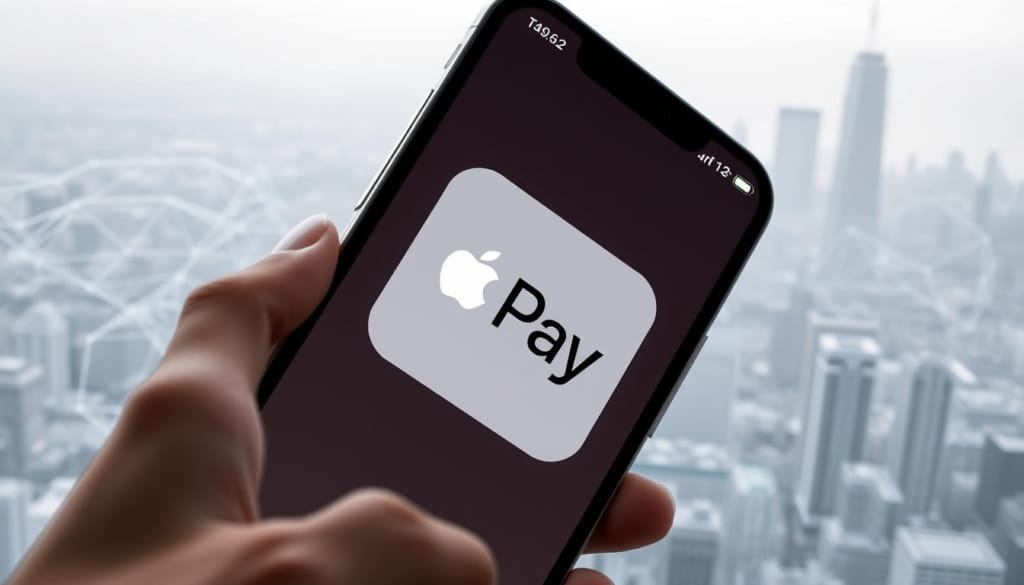The integration of traditional payment systems with DeFi is gaining momentum. Recent examples include Trust Wallet’s “Stablecoin Earn” feature and Bitget Wallet’s integration with Paydify, showcasing the potential for mainstream adoption of DeFi services.
Apple Pay and Mesh are poised to revolutionize the DeFi landscape by providing a seamless gateway to decentralized financial services. This integration could enable users to access DeFi protocols directly from their devices, making it more accessible and user-friendly.
The convergence of traditional payment systems and DeFi is expected to have a significant impact on the financial industry. As digital payments continue to evolve, the integration of Apple Pay and Mesh may play a crucial role in shaping the future of DeFi.
Key Takeaways
- Integration of traditional payment systems with DeFi is gaining traction.
- Apple Pay and Mesh could revolutionize the DeFi landscape.
- Seamless gateway to DeFi services may enhance user experience.
- Convergence of traditional payments and DeFi is expected to impact the financial industry.
- Digital payments evolution may be shaped by Apple Pay and Mesh integration.
The Current Landscape of Digital Payments and DeFi
The convergence of digital payments and DeFi is creating new avenues for financial inclusion and innovation. As the financial landscape continues to evolve, understanding the current state of digital payments and DeFi is crucial.
Evolution of Digital Payment Systems
Digital payment systems have undergone significant transformations over the years. From the early days of online banking to the current era of mobile wallets and contactless payments, the evolution has been rapid.
From Credit Cards to Mobile Wallets
The shift from traditional credit cards to mobile wallets has been a notable trend. Services like Apple Pay have made it possible for users to make payments using their smartphones, enhancing convenience and security.
The Role of Big Tech in Payments
Big Tech companies have played a crucial role in shaping the digital payments landscape. Their involvement has brought about increased competition and innovation, with companies like Google and Amazon entering the fray.
The Rise of Decentralized Finance
Decentralized Finance (DeFi) has emerged as a significant force in the financial sector, offering decentralized alternatives to traditional financial services. The rise of DeFi protocols and platforms has been remarkable.
Key DeFi Protocols and Platforms
Protocols like Uniswap and lending platforms such as Compound have become household names in the DeFi space. These platforms have enabled users to engage in various financial activities without relying on traditional intermediaries.
Current Barriers to Mainstream Adoption
Despite the growth of DeFi, several barriers to mainstream adoption remain. Regulatory uncertainty, security concerns, and user experience issues are some of the challenges that need to be addressed.

Understanding Apple Pay: Capabilities and Limitations
As the financial technology landscape continues to evolve, understanding the capabilities and limitations of Apple Pay is crucial. Apple Pay has established itself as a significant player in the digital payment systems market.
Apple Pay’s Current Infrastructure
Apple Pay’s infrastructure is built around security and convenience. It utilizes a technology called tokenization, where actual credit or debit card numbers are not stored on the device or on Apple’s servers.
Security Features and Technology Stack
Apple Pay incorporates several security features, including Face ID, Touch ID, and a unique device account number. This multi-layered security approach ensures that transactions are secure.
Integration with Traditional Financial Systems
Apple Pay is integrated with traditional financial systems through partnerships with banks and card issuers. This integration enables users to link their existing accounts to Apple Pay.
Market Penetration and User Base
Apple Pay has seen significant adoption worldwide. The service is available in numerous countries and is supported by a wide range of banks and financial institutions.
Adoption Statistics and Growth Trends
According to recent statistics, Apple Pay has experienced steady growth. The table below summarizes some key adoption statistics:
| Year | Number of Users (in millions) | Transaction Volume (in billions) |
|---|---|---|
| 2020 | 507 | 1.2 |
| 2021 | 628 | 1.5 |
| 2022 | 752 | 1.8 |
Current Limitations for Cryptocurrency Users
Despite its growth, Apple Pay has limitations, particularly for cryptocurrency users. Currently, Apple Pay does not directly support cryptocurrency transactions.

Demystifying Mesh Technology
Mesh technology is emerging as a pivotal element in the future of cryptocurrency transactions. As a decentralized network infrastructure, Mesh technology offers a robust and reliable framework for data transmission.
What is Mesh Network Technology?
Mesh network technology is a type of network topology where each node acts as a relay point, allowing data to be transmitted between nodes. This creates a web-like structure, hence the term “mesh.”
Technical Architecture and Functionality
The technical architecture of Mesh networks involves a distributed topology, where each node is connected to multiple other nodes. This allows for redundant data paths, ensuring that data transmission is maintained even if some nodes fail.
Advantages Over Traditional Networks
Mesh networks offer several advantages, including improved reliability and scalability. They are also more resistant to interference and can self-heal in case of node failures.
Mesh’s Role in Cryptocurrency Transactions
The integration of Mesh technology with blockchain and cryptocurrency is gaining traction. Mesh networks can provide a secure and decentralized infrastructure for cryptocurrency transactions.
Current Applications in Blockchain
Currently, Mesh networks are being explored for various blockchain applications, including secure data transmission and decentralized finance (DeFi) platforms.
Scalability and Performance Benefits
The use of Mesh technology in cryptocurrency transactions can lead to improved scalability and performance. This is because Mesh networks can handle a high volume of transactions without significant drops in performance.
| Feature | Traditional Networks | Mesh Networks |
|---|---|---|
| Reliability | Prone to single-point failures | Highly reliable with redundant paths |
| Scalability | Limited scalability | Highly scalable |
| Security | Vulnerable to attacks | Secure with decentralized architecture |
Apple Pay + Mesh: The New Gateway to DeFi?
Apple Pay and Mesh are on the cusp of creating a new gateway to DeFi, transforming how we interact with financial services. This integration has the potential to simplify access to decentralized finance, making it more mainstream.
The Potential Integration Process
The integration of Apple Pay with Mesh technology involves several key steps. Firstly, it requires a robust technical architecture that can support both the existing Apple Pay infrastructure and the decentralized nature of Mesh.
Technical Architecture of the Integration
The technical architecture will need to ensure seamless communication between Apple Pay’s centralized system and Mesh’s decentralized network. This interoperability is crucial for facilitating smooth transactions.
User Experience Considerations
For the integration to be successful, the user experience must be intuitive and secure. Users should be able to easily navigate between traditional payment methods and DeFi transactions without compromising security.
Technical Challenges and Solutions
Despite the potential benefits, there are several technical challenges to overcome. These include ensuring the security and privacy of transactions, as well as achieving interoperability with existing DeFi protocols.
Security and Privacy Concerns
Security is paramount when integrating Apple Pay with Mesh. Robust encryption methods and secure authentication protocols will be necessary to protect user data and prevent unauthorized transactions.
Interoperability with Existing DeFi Protocols
Achieving interoperability with existing DeFi protocols is another significant challenge. This will require developing standards and APIs that allow for seamless interaction between the Apple Pay-Mesh integration and various DeFi platforms.
The successful integration of Apple Pay and Mesh could indeed create a new gateway to DeFi, enhancing user experience and expanding the reach of decentralized financial services.
Real-World Applications and Use Cases
The integration of Apple Pay with Mesh technology is poised to revolutionize the DeFi landscape. This convergence is expected to unlock a myriad of real-world applications, transforming how we interact with decentralized finance.
Everyday DeFi Transactions
With Apple Pay and Mesh, everyday DeFi transactions become more accessible. Users can seamlessly engage in various financial activities using their Apple devices.
Retail Payments and Microtransactions
Retail payments and microtransactions are set to become more efficient, allowing for instant settlements and lower transaction costs.
Cross-Border Transfers
The integration facilitates cross-border transfers, making international transactions faster and more cost-effective.
Investment and Yield Opportunities
The combined technology opens up new investment and yield opportunities in the DeFi space, enabling users to access various financial protocols.
Accessing Lending Protocols
Users can access lending protocols, participating in DeFi lending and borrowing activities with greater ease.
Liquidity Provision and Staking
Liquidity provision and staking become more straightforward, allowing users to contribute to liquidity pools and stake their assets for rewards.
Enterprise and Institutional Applications
Beyond individual users, the integration has significant implications for enterprise and institutional applications.
B2B Payment Solutions
B2B payment solutions can be streamlined, reducing the complexity and cost associated with business-to-business transactions.
Treasury Management
The technology also enhances treasury management for institutions, providing more efficient and secure ways to manage financial assets.
| Application Area | Benefits | Potential Impact |
|---|---|---|
| Everyday DeFi Transactions | Efficient retail payments and microtransactions | High adoption rates |
| Investment and Yield Opportunities | Access to lending protocols and liquidity provision | Increased DeFi participation |
| Enterprise and Institutional Applications | Streamlined B2B payments and treasury management | Significant cost savings |
Potential Impact on the Financial Ecosystem
As Apple Pay and Mesh converge, the financial landscape is on the cusp of a significant transformation. This integration has the potential to disrupt traditional financial systems, accelerate cryptocurrency adoption, and raise important regulatory considerations.
Disruption to Traditional Banking
The integration of Apple Pay and Mesh could significantly alter the traditional banking landscape. Key areas of disruption include:
- Reduced transaction fees
- Increased transaction speed
- Enhanced security through blockchain technology
Changing Role of Financial Intermediaries
Financial intermediaries may need to adapt their business models to remain relevant. This could involve embracing blockchain technology and offering DeFi services.
Response Strategies from Incumbent Institutions
Incumbent financial institutions may respond by investing in financial technology and forming partnerships with fintech companies.
Effects on Cryptocurrency Adoption
The integration could lead to increased cryptocurrency adoption. Key effects include:
- Mainstream user onboarding
- Potential increase in cryptocurrency value
Mainstream User Onboarding
Apple Pay’s user base could be onboarded into the cryptocurrency market, increasing adoption rates.
Market Implications for Major Cryptocurrencies
The integration may have significant implications for major cryptocurrencies, potentially leading to increased market volatility.
Regulatory Considerations and Challenges
Regulators will need to address the challenges posed by this integration. Key considerations include:
- Anti-money laundering (AML) and know-your-customer (KYC) regulations
- Consumer protection
Current Regulatory Landscape
The current regulatory landscape is evolving, with various jurisdictions implementing different approaches to regulating DeFi and cryptocurrency.
Potential Policy Developments
Future policy developments may include clearer guidelines on DeFi and cryptocurrency integration with traditional payment systems.
Conclusion
The integration of Apple Pay and Mesh technology has the potential to revolutionize the DeFi landscape, creating a new gateway to decentralized finance. As discussed, this integration combines the widespread adoption of Apple Pay with the decentralized, secure nature of Mesh technology, paving the way for a more accessible and user-friendly DeFi experience.
By bridging traditional payment systems with the world of cryptocurrency, Apple Pay + Mesh: the new gateway to DeFi can significantly enhance the adoption of decentralized finance. This synergy is poised to disrupt traditional banking models, offering users more control over their financial transactions and investments.
As the financial ecosystem continues to evolve, the potential impact of this integration on cryptocurrency adoption, regulatory considerations, and institutional applications will be significant. Embracing this change, stakeholders can unlock new opportunities in the DeFi space, driving innovation and growth in the decentralized finance sector.

